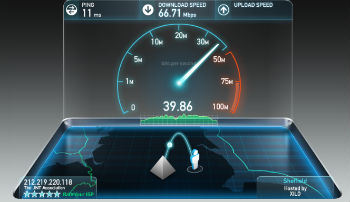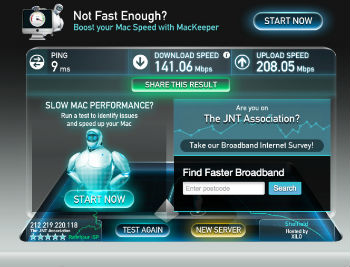 Day two in the
Day two in the big brother house new office (spoken with Geordie accent) and I’ve just done a broadband speed test. For the moment my network connection is a WiFi hotspot on a 4 year old iMac which is in turn connected to an Ethernet socket in the wall. Tomorrow we will be bringing in a router.
With this setup I’ve just done a speed test and as you can see got 66Mbps down with an equally good 40Mbps up. Impressivo. Remember this is through the iMac.
 The iMac itself connected directly to the Ethernet port gets even better speeds. On this occasion 141Mbps down and a whopping (the Sun says) 208Mbps up.
The iMac itself connected directly to the Ethernet port gets even better speeds. On this occasion 141Mbps down and a whopping (the Sun says) 208Mbps up.
This must be a GigE LAN. Will have to investigate. I’m told that in the wee small hours when most of the whole wide world is fast asleep it gets even faster. It’s likely constrained by the speed of the Ethernet card in the Mac. Clearly it’s must be locally shared bandwidth.
This is all because the network is run by the University of Lincoln who of course will be attached to Janet.
At this point I’d like to thank Rob Evans (@rhe), who runs the Janet network, for his efforts here. Rob doesn’t mess about down at 1Gbps speed I know. He is more into 100GigE but nevertheless thanks Rob 🙂
I had intended to do some trade study work into various broadband services as part of being able to recommend providers. In the case of the office this would be futile so I will at some point do it on my home connection. I currently use Timico and see no real reason to change seeing as I know the network.
However I sense that I will want to move to FTTP on demand and also as a consumer might want to avail myself of TV and or sport bundles which as a B2b pureplay Timico doesn’t offer so watch this space for news on that score.
